
Portland Magazine
Performing and Fine Arts
July 25, 2023
The story of an instrument and two of its makers, more than a century apart.
Story by Cheston Knapp
Images and Video by Christopher Brecht

THE CLASSICAL GUITAR continues to be deeply connected to its historical roots, and luthiers the world over learn the mournful story of Antonio de Torres Jurado, a poor Spanish carpenter who altered the instrument’s DNA in the middle of the 19th century and unlocked its full expressive potential.
When he was eighteen, in order to avoid fighting in a civil war, Torres was hustled into an arranged marriage with the thirteen-year-old daughter of a shopkeeper. They had three girls and lived hand to mouth. Debts piled up, two of his daughters died. Then TB ushered his wife into the ground at twenty-three. Bereft, Torres went off in search of a way to change his life’s tune. How or when he learned to build guitars, no one knows. But he emerged in the 1850s as a master craftsman, an ingenious and pioneering producer of a newly renovated, world-class instrument. It was recognizable as a guitar in the way a grown man is to the nine-year-old boy he once was. Its voice had dropped. Its tone was broader, deeper. It had a newfound swagger and magnetism.
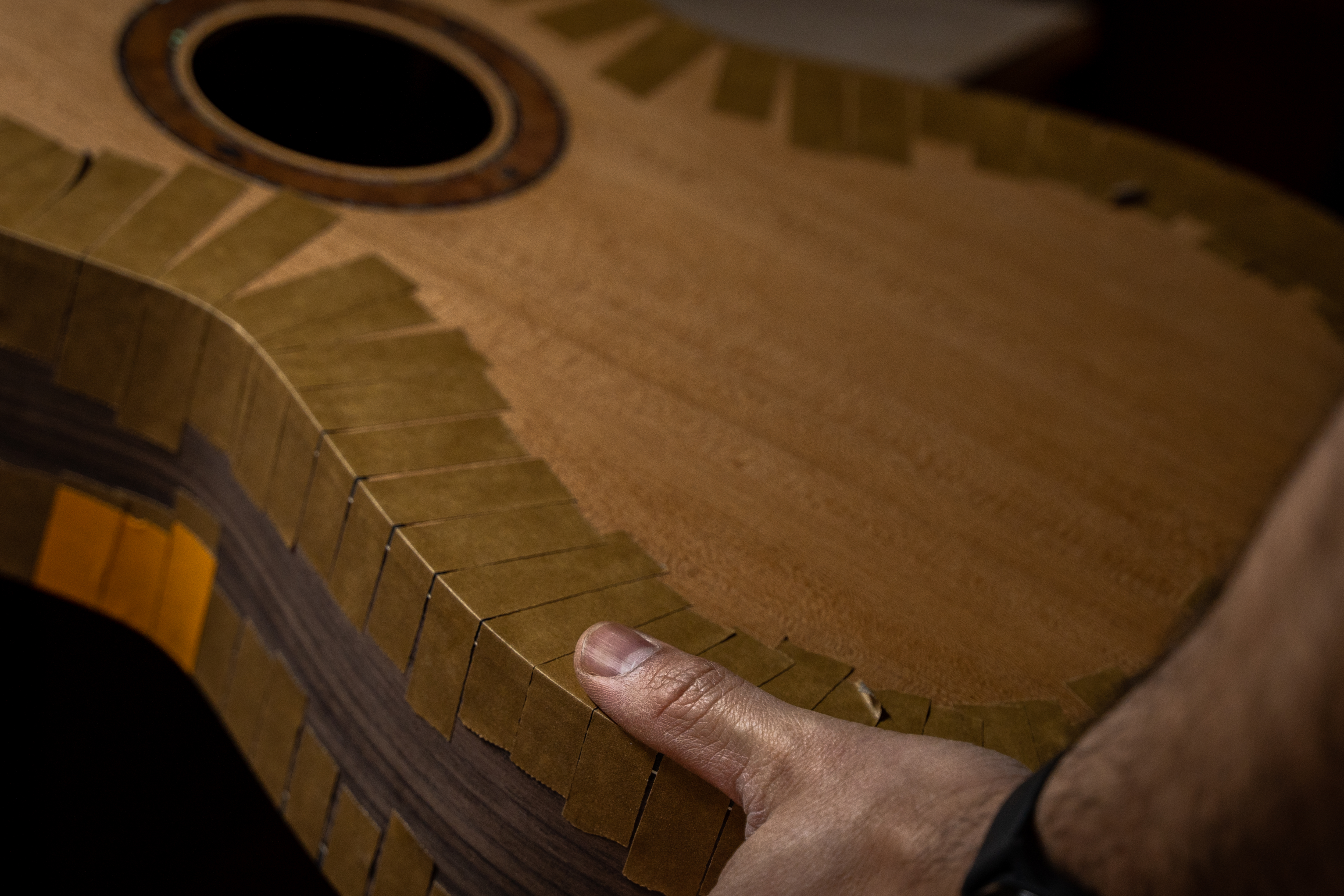
Apprentices learn these facts, but what they hear, when they listen to a gifted musician play a top-notch classical guitar, is Torres’s fear at the thought of going to war and his relief at being married. They hear the time his wife danced with a broom in their candlelit kitchen and he realized that he actually loved her. They hear his anxiety at the creditors arriving to impound his wood, to seize his saw. They hear his joy at his daughters’ births and the despair he endured while building two petite caskets. They hear the terror he felt when his wife showed him the alarming red stain on her handkerchief. They hear all of Torres’s grief and pain, his resilience and hope—the entire welter of emotion that he managed to pour into a humble instrument that, at the time, was favored mostly by vagabonds and peasants.
And while the craft has, of course, continued to progress under the care of other expert craftsmen, the fundamentals haven’t changed much. What Torres created, basically, was a whole new genus of guitar, one robust enough to support a remarkable diversity of species, including the crackerjack specimens fashioned by Maxwell Sipe ’04.
Max works out of an unassuming garage behind his house in Northeast Portland. Nothing about the structure’s modest exterior prepares you for what you find inside, like the Narnia wardrobe.
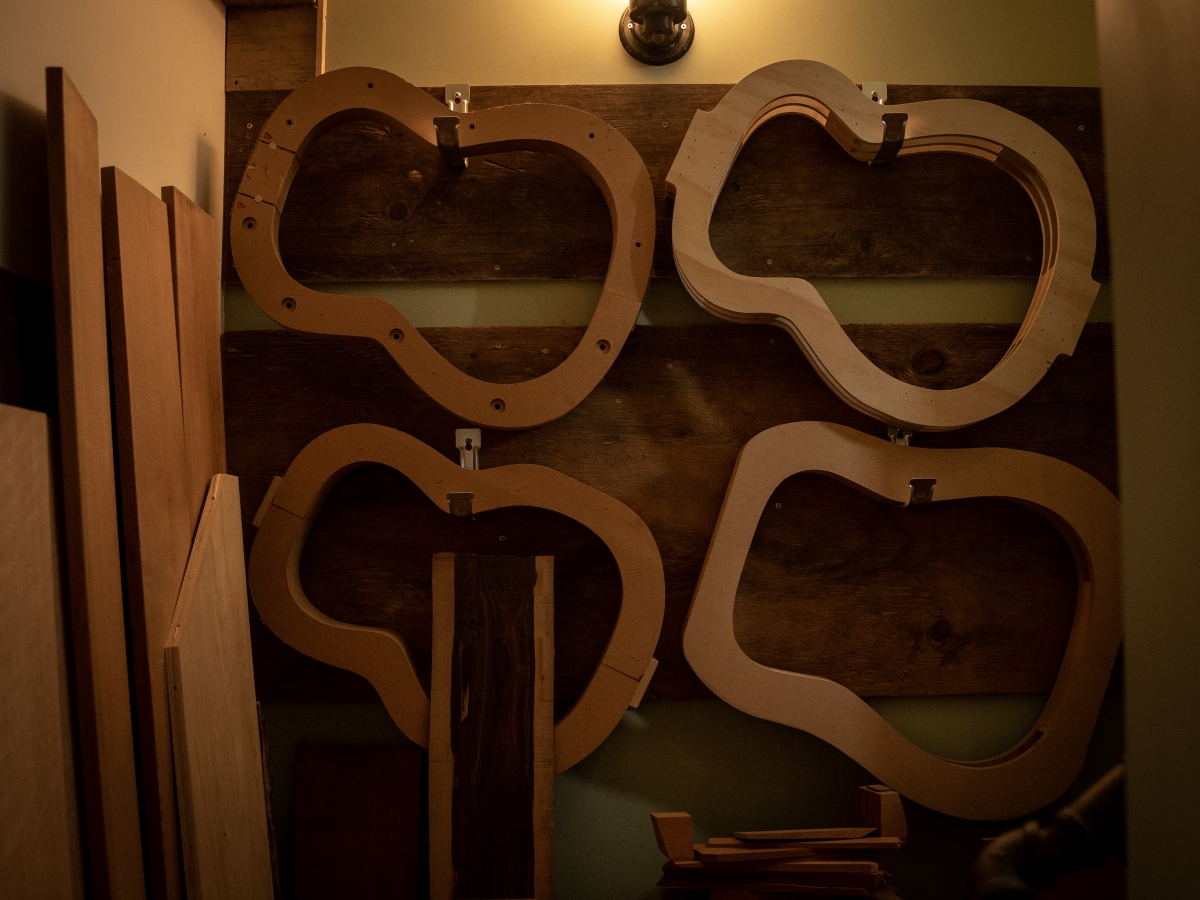 As I entered for a visit back in the spring, I was hit by the smell of wood shavings and the faintest suggestion of glue. The walls were crowded with all the accoutrements of fine joinery work: chisels, T-squares, saws, rulers, vice grips, braces, tape, rags, rectangular pencils, etc. The twin halves of more than a hundred soundboards were stored on shelves above the entrance—the space is temperature- and humidity-controlled to ensure they don’t warp or buckle. Underneath the work-benches that line the space were guitar molds ("solera") and veneers and prototypes of different guitar shapes ("plantillas"). A large vacuum tube snaked across the ceiling; its business end lay coiled in the far corner. On a table saw rig in the middle of the room sat the body of an unfinished guitar. Its unattached neck rested beside it with just enough intention to suggest the inspiration for a Cubist painting. Turns out these were the makings of his one hundredth guitar.
As I entered for a visit back in the spring, I was hit by the smell of wood shavings and the faintest suggestion of glue. The walls were crowded with all the accoutrements of fine joinery work: chisels, T-squares, saws, rulers, vice grips, braces, tape, rags, rectangular pencils, etc. The twin halves of more than a hundred soundboards were stored on shelves above the entrance—the space is temperature- and humidity-controlled to ensure they don’t warp or buckle. Underneath the work-benches that line the space were guitar molds ("solera") and veneers and prototypes of different guitar shapes ("plantillas"). A large vacuum tube snaked across the ceiling; its business end lay coiled in the far corner. On a table saw rig in the middle of the room sat the body of an unfinished guitar. Its unattached neck rested beside it with just enough intention to suggest the inspiration for a Cubist painting. Turns out these were the makings of his one hundredth guitar.
Like a lot of luthiers, Max’s pursuit of the craft began with a love of the music.
"I don’t think I’d be in this if I hadn’t been a player first," he told me. In his trucker cap and denim apron, he gave off the humble, self-effacing vibe I associate with serious wood-workers. Dealing with such an obstinate substance must teach them to be as patient as preschool teachers.
Primarily an electric guitar guy growing up, Max didn’t pick up the classical one until college, when he took a class with Jeff Ashton, who’s been teaching at the University for more than thirty years. The experience kindled an interest that, prestissimo, became a passion. He ended up majoring in music, the only guitarist in his class.
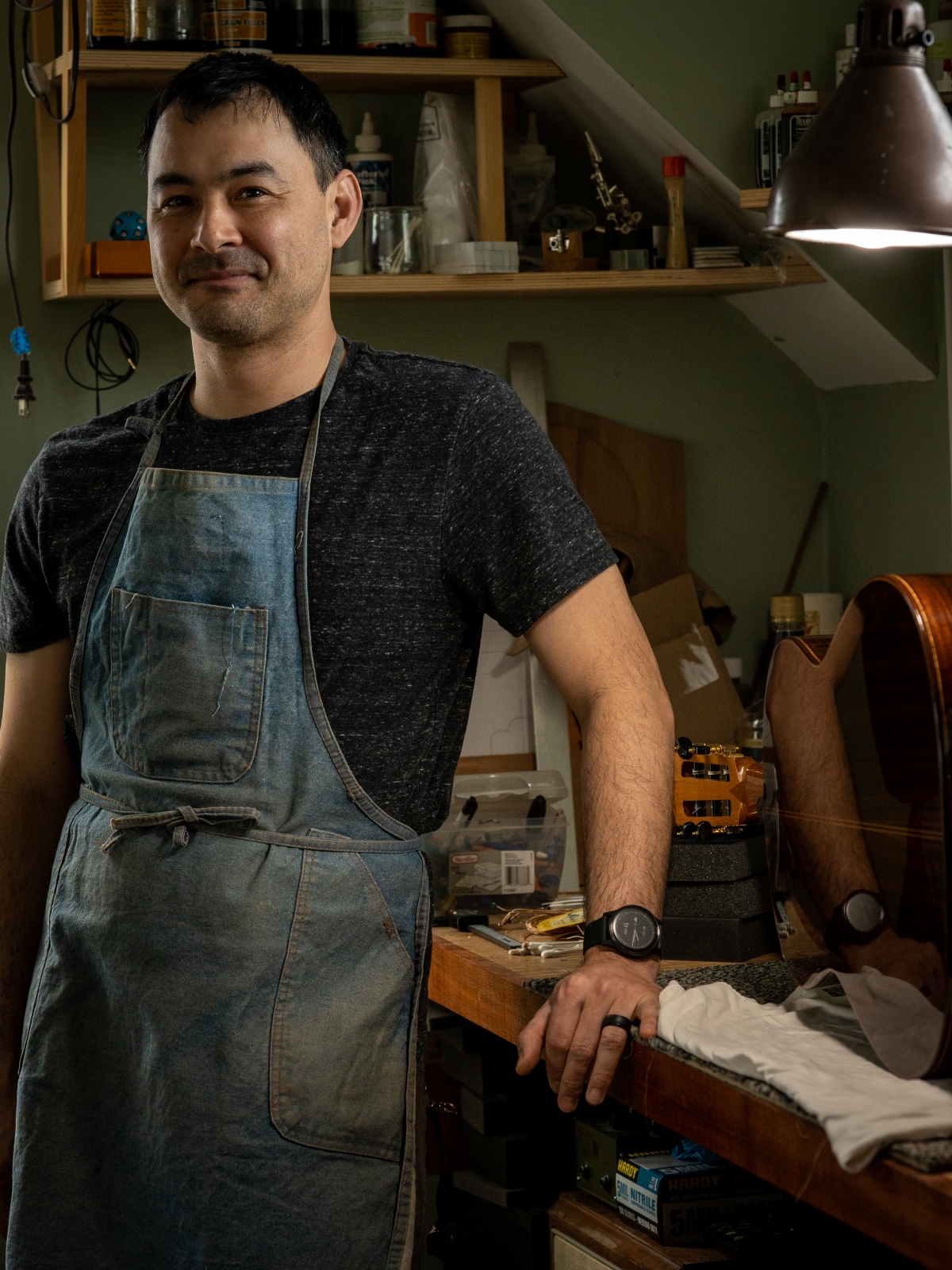
"The sound hits your ear like a voice," Max said. "It’s really more like a violin."
In music, timbre is the idea that every instrument has a kind of auditory fingerprint, a quality of tone that distinguishes it from all other instruments and accounts for its unique magic. As a smell, the classical guitar’s timbre would be pipe smoke, leather, and loam; as a taste it’d be a spendy Spanish sherry, nutty and a touch sweet; and in color it’d be a Rothko confection, a medley of earthy oranges, browns, and reds. It’s a reflective, soulful tone, wistful and nostalgic, full of vague longing. And decidedly more intimate than the timbre of its steel-strung counterpart. Everything about it, in fact, is more intimate, down to the way you hold it, propping it on your left knee and embracing it like you would a lover, leaning in close as though you had sweet nothings to whisper to it. The thought of throwing a strap on one and thrumming out the chords of “Knockin’ on Heaven’s Door” feels borderline sacrilegious. You’d never call it an ax. And no matter how fast and dexterous the playing gets—very fast, muy dexterous—you wouldn’t be tempted to call it shredding. It excels at subtle modulations of tone and color, which is of course to say that it excels at producing subtle modulations of emotion and mood, a range and depth that Torres had set out to capture. And it plays multiple parts at once (bass, melodies, harmonies)—only the piano can rival it for this versatility.
“You’re like the orchestra up there,” he said. “You’re complete.”
After graduation, Max taught lessons and did some small concerts around town. But at some point, he had to acknowledge how long, hard, and unforgiving the road of a playing career would be. He still loved the instrument, though, and had been a tinkerer since way back, and soon found a job doing repairs for a local luthier named Kerry Char, whose workshop isn’t far from The Bluff.
This was a formative experience for him.
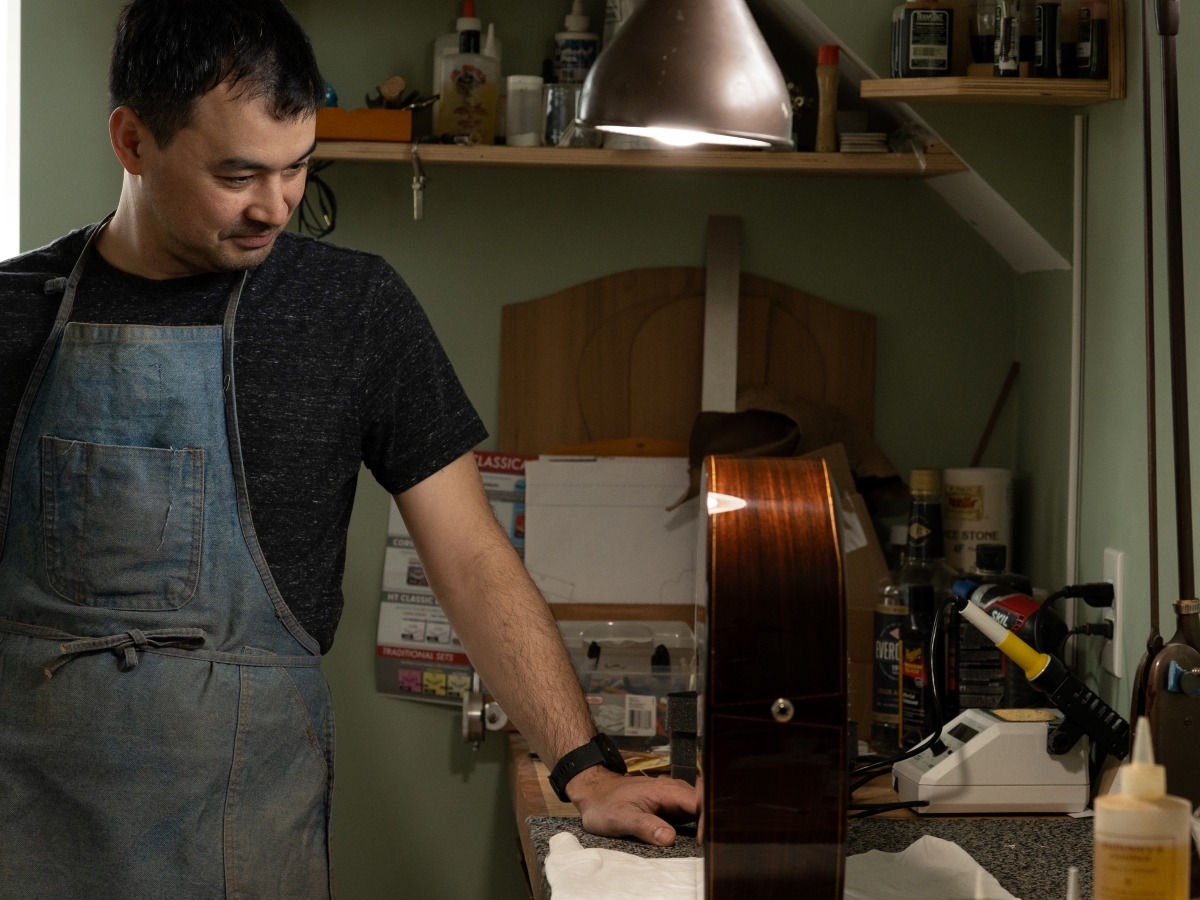
“It really expanded my sense of the sound these guitars can make,” he said. “And taught me what not to do in many ways.”
After years developing his skills, learning from others’ mistakes, and turning out apprentice instruments, he made the leap to go out on his own. And he’s been successful enough now to have the luxury of turning down a steady stream of repair work and to rely on the sales of his guitars for the lion’s share of his income.
At first blush, the guitar doesn’t seem to be all that complex an apparatus. A wooden box is fitted with a whittled down two-by-four that has half a dozen metallic doohickeys at the top; thread some catgut strings through those and bingo, you’re in business. It’s easy to imagine an enterprising DIY company packaging one as a kit. But as the old saw goes, the devil’s in the details.
One of Torres’s inspired insights had to do with the soundboard, the top. He bucked prevailing wisdom and reasoned that it was the most important factor in producing the guitar’s sound, not the hollow box underneath. In order to prove his theory, Torres built a guitar whose back and sides were made of papier mâché and it played just fine. Listening to recordings made with this guitar online, you’d never know that its body was water-soluble. This, in part, helps explain why he increased the size of the instrument by about twenty percent—his soundboard’s larger surface area helped create a more euphonic voice. And while there might be some mathematical justification for its shape, legend goes that he modeled it on a beautiful woman he saw in Seville.
As he continued to experiment, Torres found that the sound improved with a thinner soundboard. But the thinner you go, the more you compromise the integrity of the wood. At a certain point it starts to behave something like a sun hat. To support a soundboard of less than 2.5mm, roughly twenty-five sheets of printer paper, Torres developed a system of bracing called fan struts. The underside of his soundboards looked like an eye, with seven eyelashes fanning out around the soundhole. Since Torres’s day, luthiers have engineered other types of bracing—this is where most of the craft’s innovation and experimentation occurs.
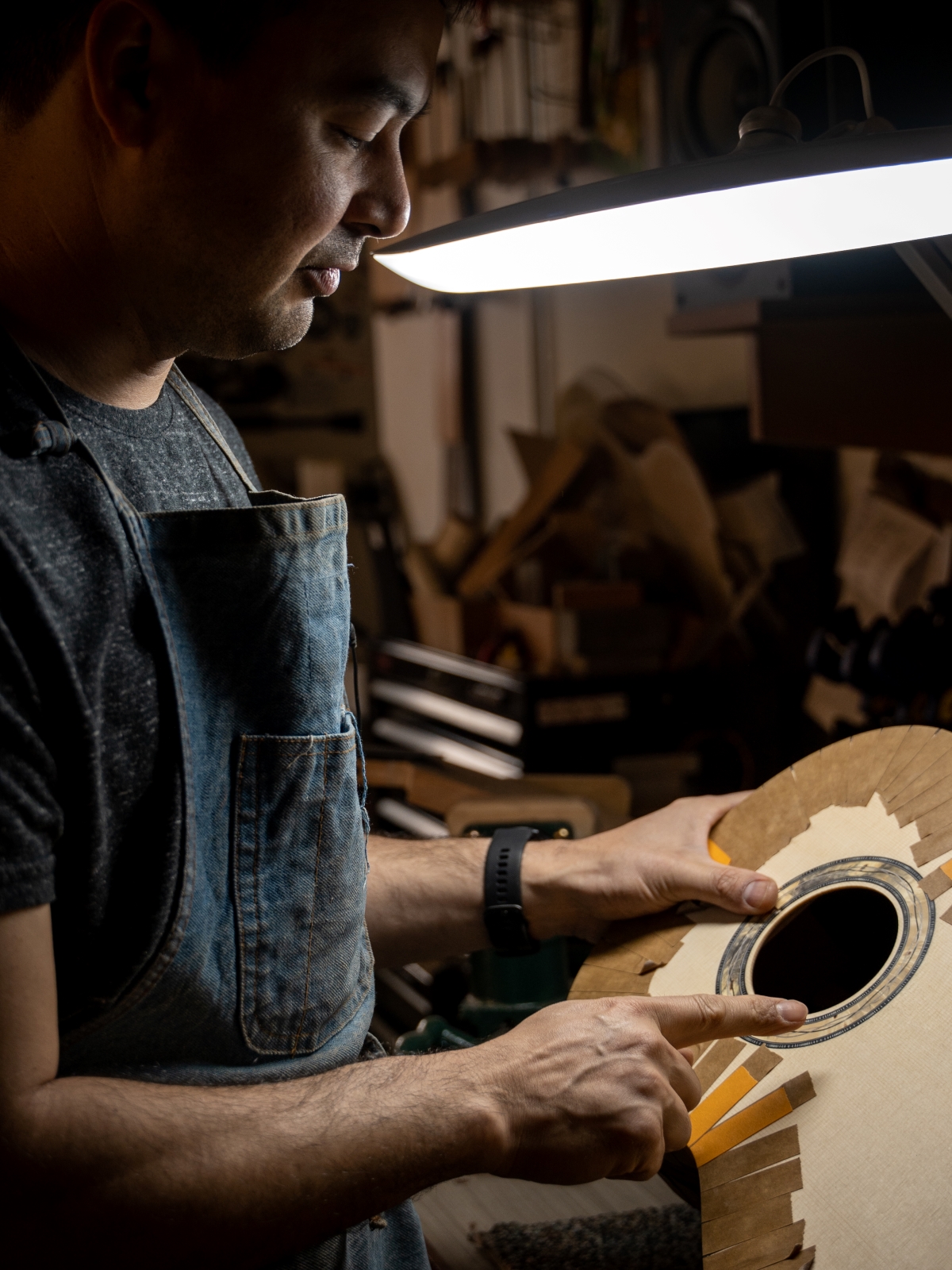 “Everyone does it differently,” Max told me, and held up an example of the lattice strutting that’s become his gold standard. He likes to use soundboards that fall in the 1.5–1.7mm range, which require more elaborate trussing than the system Torres used. Inspired by the work of Philip Woodfield and Thomas Humphrey, he designed and fabricated his own lattice, resulting in a sound that’s all his own. “This goes with and across the grain and can support a thinner top.”
“Everyone does it differently,” Max told me, and held up an example of the lattice strutting that’s become his gold standard. He likes to use soundboards that fall in the 1.5–1.7mm range, which require more elaborate trussing than the system Torres used. Inspired by the work of Philip Woodfield and Thomas Humphrey, he designed and fabricated his own lattice, resulting in a sound that’s all his own. “This goes with and across the grain and can support a thinner top.”
Soundboards are typically made of soft tone woods like spruce or cedar, because they’re light and stiff. The sides, called ribs, and back are often harder tone woods like mahogany or rosewood. When choosing a tone wood, Torres would have held a piece of wood up to his ear and tapped it in various places, listening close, like a yeggman cracking a safe. And while people still do that, science-minded luthiers have figured out how to approximate the process with data. When Max gets a fresh piece of tone wood, he measures its length, width, and density, and determines the peak frequency both with and across the grain, which will give him an idea of its qualities of a soundboard.
“It’ll get you in the ballpark, at least,” he said.
Upmarket luthiers like Max don’t work in a vacuum. They work in concert with players. Peek behind the curtain of every great guitarist and you’ll find an equally great luthier. Tarrega and Llobet had Torres. Andres Segovia had Herman Hauser. John Williams had Greg Smallman. A luthier is like an auto mechanic: he builds and maintains (tunes up, as it were) the vehicle that someone else drives. And every new guitar is a collaboration, a melding of musical minds.
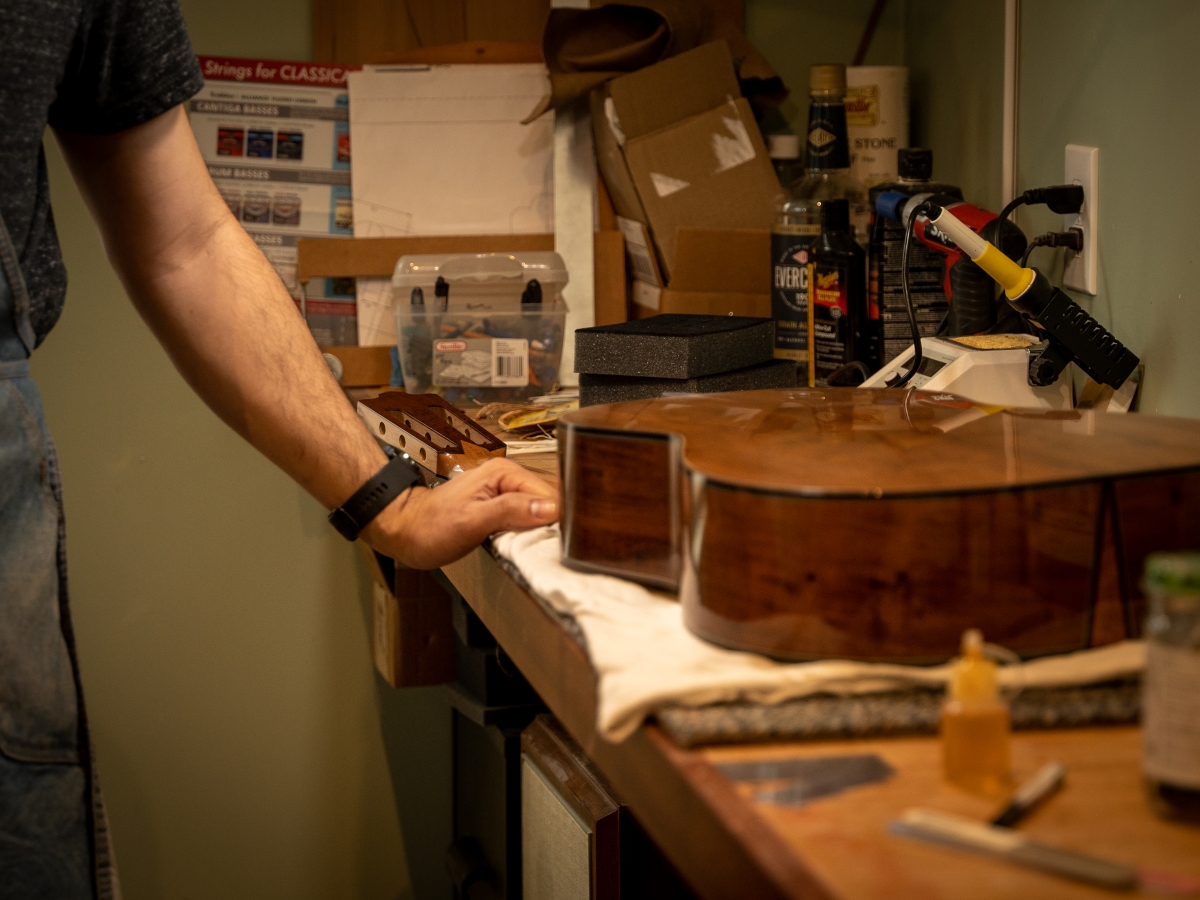
“What people can hear is so varied,” Max said. “Some people even hear in color. What some of these guys hear is so subtle that most people, just, won’t hear it. But they do.”
He’s established a fruitful working relationship with a handful of musicians in the Northwest, including Cameron O’Connor, an accomplished, soulful player who teaches at Oregon State University. O’Connor owns a couple of Max’s guitars and encourages his students to use them, too. In an industry driven largely by word-of-mouth, Cameron’s been a benevolent Pied Piper figure for Max, but only because he’s been so happy with the product.
“I would take guitars in to Max that had some of the essence I was looking for,” he said of their relationship. “We play polyphonic music and each string has the ability to become the king of the guitar at any moment. I wanted a clarity and separation of these voices, a certain sweetness in every register, and this boost in the mid-range."
Max then had to figure out how to translate this information, how to sculpt an instrument to fit what Cameron hears. He experimented, tinkered, and ultimately developed his take on the lattice bracing.
"Max came up with a startlingly beautiful guitar," Cameron said. "He does such a good job of taking ideas and turning them into a wonderful, working end product."
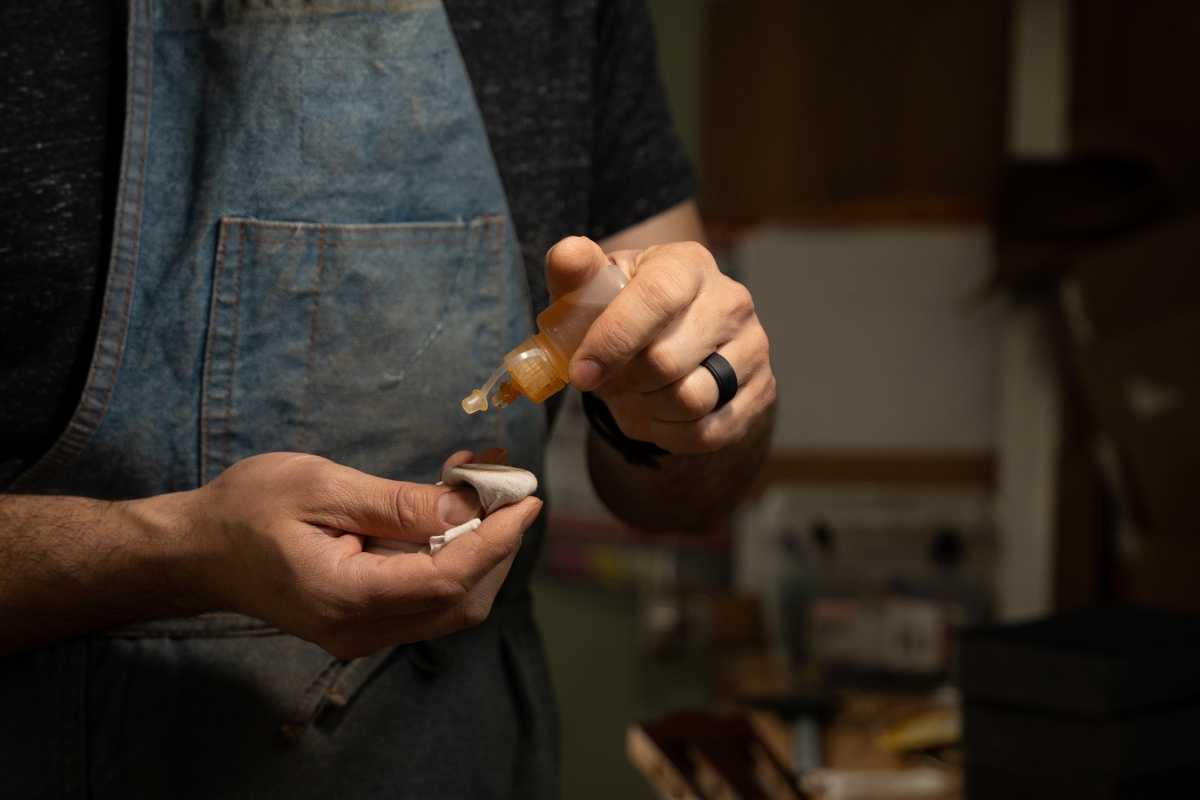 Like every serious craftsman, Max lives by a philosophy of n+1: he believes the next guitar is going to be his best yet. On a follow-up visit, I noticed that the neck had been attached to No. 100 and it had a high, watery sheen, the moistness of an eye about to cry. To achieve this finish, he uses a labor-intensive and exceedingly delicate process called French polishing. Upstairs in his shop, he showed me how it’s done. He applied a few droplets of shellac to a “muñeca,” a gobbet of wool wrapped in a t-shirt rag, and diluted it with Everclear. He then rubbed the muñeca across the back of No. 100 and we watched as the alcohol evaporated like breath on a window, leaving behind an infinitesimal amount of shellac. He’ll repeat this process hundreds and hundreds of times, applying the shellac slowly, methodically, almost imperceptibly, just as passing days age us. It’s so demanding that few people do it. And few do it better than Max—Cameron called him "the prince of polish."
Like every serious craftsman, Max lives by a philosophy of n+1: he believes the next guitar is going to be his best yet. On a follow-up visit, I noticed that the neck had been attached to No. 100 and it had a high, watery sheen, the moistness of an eye about to cry. To achieve this finish, he uses a labor-intensive and exceedingly delicate process called French polishing. Upstairs in his shop, he showed me how it’s done. He applied a few droplets of shellac to a “muñeca,” a gobbet of wool wrapped in a t-shirt rag, and diluted it with Everclear. He then rubbed the muñeca across the back of No. 100 and we watched as the alcohol evaporated like breath on a window, leaving behind an infinitesimal amount of shellac. He’ll repeat this process hundreds and hundreds of times, applying the shellac slowly, methodically, almost imperceptibly, just as passing days age us. It’s so demanding that few people do it. And few do it better than Max—Cameron called him "the prince of polish."
It was mind-boggling to imagine how much time Max puts into a guitar before he can test it. Throughout its months-long gestation, its voice remains a question mark, an enticement.
"It’s like Christmas morning," he said, describing the first time he puts strings on a guitar. "But I’m just waking these instruments up."
There was a philosophical flavor to how he said this, a borderline metaphysical implication that suits an instrument capable of producing such haunting music. Waking them up from what? And from where?
"Sometimes they come back to me," he said. He’d recently bought two from a former client who’d developed arthritis and could no longer play, a fact that filled the room with a palpable sadness. After the downbeat, I asked whether he’d mind playing something for me on one of them. I’d noticed he maintained the slightly lycanthropic fingernails of a serious finger-picking guitarist.
"Sure," he said, a little bashful. He sat on a chair and propped his left foot on a pedal and embraced the guitar, his guitar. The silence that filled the room was the opulent, trance-like silence that always precedes a musical performance. He was tuning in to something I couldn’t yet hear, the place where music comes from. And then he took a deep breath and began to play. The fingers of his right hand tickled the strings as those of his left danced along the length of the neck and even though it was just the two of us there in his shop, you could feel the presence of a new being fill the room, a ghost full of grief and stubborn joy. The voice of the guitar was so personal that it was easy for me to imagine it was the spirit of a heartbroken man more than a century dead, a spirit grateful for the knowledge that the instrument he gave to the world is in good hands.
CHESTON KNAPP is Portland magazine’s senior writer and associate editor.
University of Portland
5000 N. Willamette Blvd.,
Portland, Oregon 97203-5798
503.943.8000
This website uses cookies to track information for analytics purposes. You can view the full University of Portland privacy policy for more information.
